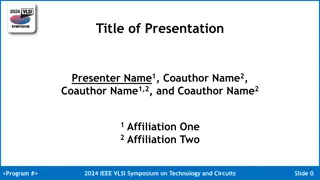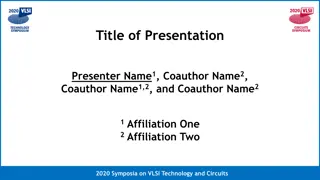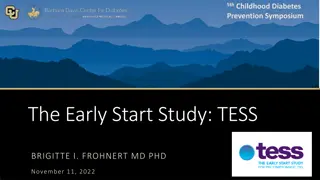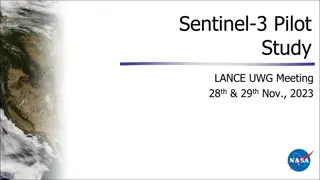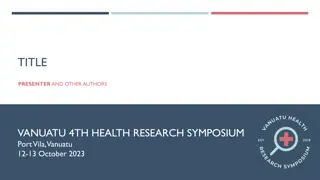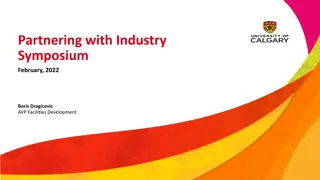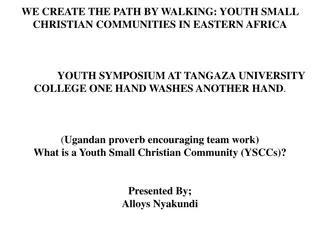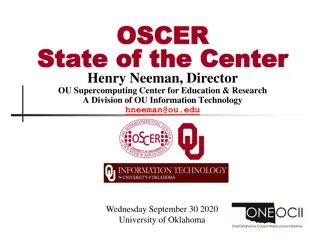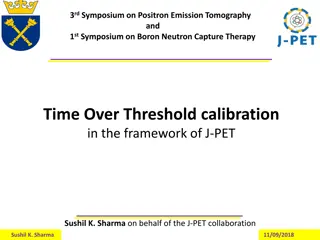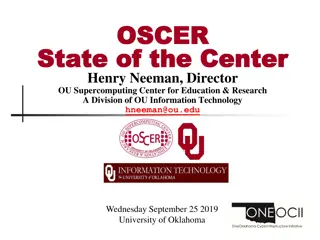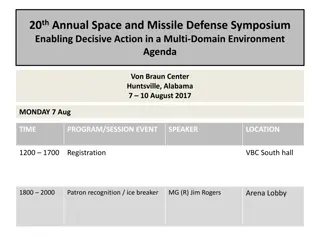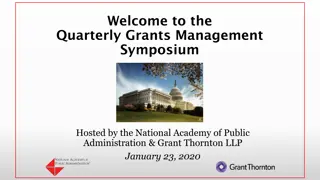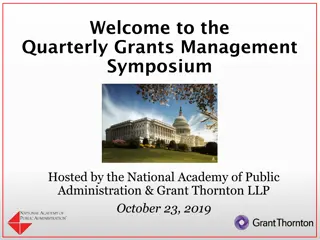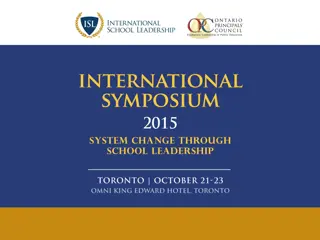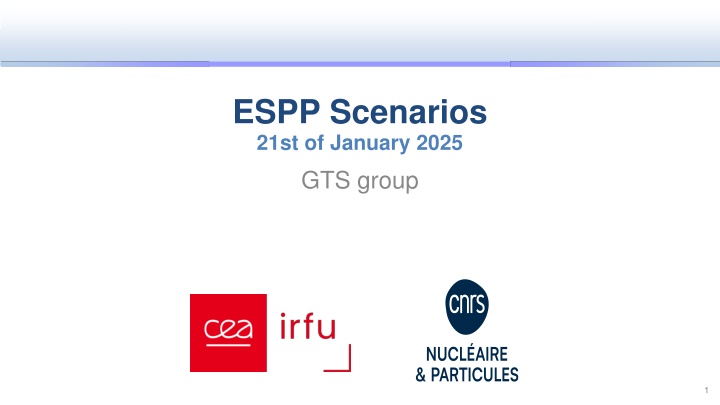
Exploring Future Particle Collider Options in European Physics Community
The content discusses the European particle physics community's ambition to enhance scientific capabilities through future collider projects. It touches on the prioritization of an electron-positron Higgs factory and a proton-proton collider with high energy levels. The French contribution to the ESPP process, addressing ECFA questions, and synthesizing the French community's stance are highlighted. Contributions received encompass various topics, including collider options, experiments, sustainability, computing, and artificial intelligence. The overview illustrates the diverse range of input from laboratories and projects, emphasizing the community's engagement in shaping the future landscape of particle physics.
Download Presentation

Please find below an Image/Link to download the presentation.
The content on the website is provided AS IS for your information and personal use only. It may not be sold, licensed, or shared on other websites without obtaining consent from the author. If you encounter any issues during the download, it is possible that the publisher has removed the file from their server.
You are allowed to download the files provided on this website for personal or commercial use, subject to the condition that they are used lawfully. All files are the property of their respective owners.
The content on the website is provided AS IS for your information and personal use only. It may not be sold, licensed, or shared on other websites without obtaining consent from the author.
E N D
Presentation Transcript
ESPP Scenarios 21st of January 2025 GTS group 1
Reminder of the context Outcome ESPPU 2020 Full exploitation of the high-luminosity LHC upgrade An electron-positron Higgs factory is the highest-priority next collider. For the longer term, the European particle physics community has the ambition to operate a proton-proton collider at the highest achievable energy. Europe, together with its international partners, should investigate the technical and financial feasibility of a future hadron collider at CERN with a centre-of-mass energy of at least 100 TeV and with an electron- positron Higgs and electroweak factory as a possible first stage 2
Reminder of the context ECFA questions (excerpt) Which is the preferred next major/flagship collider project for CERN? Beyond the preferred option, what other accelerator R&D topics (e.g. high- field magnets, RF technology, alternative accelerators/colliders) should be pursued in parallel? What is the prioritised list of alternative options if the preferred option is not feasible (due to cost, timing, international developments, or for other reasons)? 3
The French contribution to ESPP Mandate GTS: Do a synthesis of the French community positioning on the ESPP process Address ECFA questions and prepare FR national input to ESPP. Input setup GT1-4 executive summaries, Laboratories submissions, Direct submissions to GTS, Community discussions : GTs meetings, FR-ESPP Symposium. 4
Overview of received contributions About 60 contributions received. Contributions from laboratories: 2 contributions from IRFU, 10 contributions from in2p3 institutes (CPPM, IP2I, LAPP(2), LPNHE, IPHC, LLR, GANIL(2), IJCLab). Contributions from projects FCC, LCF, Muon Collider, LHCb, Belle2, EIC, LHeC... Various topical contributions to GT1-4 Higgs, EWK, top, QCD, detector concepts, networking, computing, AI, sustainability etc... Covers several options for the next collider at CERN, and also discuss other colliders and experiments (Belle 2, EIC, LHC, HL-LHC etc ). Transversal : sustainability, computing/AI, R&D. 6
Overview of received contributions As first GT : 11 (GTS), 17(GT1), 8(GT2), 1(GT3), 5(GT4), Sustainability/ecology (4),Instrumentation(4), Computing/AI (4) As second GT: 13 (GTS), 7(GT1), 3(GT2), 0(GT3), 4(GT4). 7
GTS meeting 18th of December GTS meeting organised on December 18, to precise the contributions and discuss baseline options and backup plans. https://indico.in2p3.fr/event/34334/ ~80 participants Agenda : Feedback from the individual GTi, Feedback from IN2P3 institutes and IRFU which submitted contributions. More in2p3 institutes sent contributions since then. Summary and discussions about sustainability, Summary and discussions about instrumentation, First synthesis from the GTS and discussions. (A consensus for a baseline option emerged.) 8
Future colliders@CERN Options discussed in the contributions: e+e- ep pp (*) Nb3Sn 16T (**) Nb3Sn 14T (***) HTS 20-40T + - 9
Arguments for the present update Premise : Maintain/support the on-going programs at the LHC as well as non- collider projects. For future projects, strategic criteria can be classified as follows : 1. Scientific and technical criteria, 2. Strategic positioning of EU and France, 3. Transverse arguments. 10
1.Scientific and Technical criteria Should consider the results of the latest European Strategy Update (2020, link), with priority being An electron-positron Higgs factory . Has the strongest physics program possible, as wide as possible. Leads to innovative R&D, both on the accelerator and detector sides. Has multiple collision points, allowing for topical detector designs. Allow for upgrades (energy, luminosity and/or hh collisions). Should be implemented reasonably soon after the end of HL-LHC (transmission of expertise and know-how). 11
2. Strategic positioning Ensure that CERN remains the leader of high energy physics. Long term scientific and technology (societal) impact, Maintain ability to perform large scale scientific programs, Also in view of potential competition with other continents. As a hub of expertise for non-collider experiments Neutrino physics, Dark Matter experiments, QED precision measurements, As a platform that demonstrates the r le of fundamental (physics) research impact for society France to benefit from this positioning: As a host country, Maintain scientific leadership in key FR areas, Perform a strong and balanced R&D, Preserve and develop Know-how in FR Laboratories, Positive impact on the French visibility, attractiveness, education and links to universities. 12
3. Transverse aspects Strong feedback from the community on Eco-responsibility and Sustainability. There is a clear expectation from the community to work on minimising the ecological footprint, even stronger expectations for the young researchers, Minimising the ecological impact of any future collider is particularly important for the acceptance of the project not only by society, but also within our own community, Should be accounted for in R&D programs. Cost is an important aspect, not in the focus of the current process: Direct comparisons of physics benefits vs cost is non-trivial, The projects with the highest physics impact are also the most costly, ~10-15 GCHF for the construction only. International context and inter-dependencies: Contributions from non-European countries is of course essential. Other competitive projects might appear on other continents. 13
Baseline choice for the future collider at CERN FCC has high priorities in a large fraction of the contributions: FCCee as first priority for the GT1 and GT4 (Tera-Z+FCChh), Tera-Z with a circular collider as a priority for GT2, IN2P3: lab/oratory contributions support in the FCC program, IRFU : strong support for the FCC integrated program as Option A . A majority of received contributions are dedicated or mentioning FCCee as the next future collider at CERN. The environmental impact of the project is a major aspect. This has been confirmed during the GTS December meeting to reach a consensus: Clear agreement for the next collider at CERN: FCCee Opportunity to explore the energy frontier by the FCChh in a later stage. 14
Baseline choice Additional considerations The choice of the baseline by the community has been actually driven by Physics first Acknowledging the change of paradigm that the BSM energy scale is to be established : FCC-ee offers the broadest spectrum of precision measurements (adding to Higgs precision physics, consistency and deviation checks from Flavour physics, QCD and gauge sector). A number of contributions have mentioned sustainability as a driver for the next project. The report will make a strong statement that CERN and the HEP community should reduce, by all means possible, the ecological impact of its activities, starting with the next collider at CERN. The sustainability of the project is alongside a requirement for many of us. The LCA of the main projects is a clear step forward in this direction. 15
Beyond the main priority: the strategic decision tree The strategy chart explicitly mentions a number of major/flagship projects, defined by ESG Plan B to be considered in case Plan A is not feasible. A non-exhaustive and non-ordered list of possible reasons are: insufficient funding, insufficient support, different societal priorities, environmental cost; the construction of a competitive project elsewhere is established, and ahead of the European project; ... Beyond those major projects, there will be a number of activities that Europe and CERN will have to consider as strategic : ability to respond to international project construction, sufficient room for specialised experiments (DM, neutrino, flavour, nuclear....) using platform approach, innovative R&D etc. 17
Major projects with significant FR interest Qualitative table summarizing the self-proclaimed scientific focus of the various options From published achievable precision in key measurements, energy & luminosity reach Disclaimer 18
Alternatives to FCC-ee : feedback from the GTs GT1 (SM tests and Higgs) a LCF at CERN (operating up to at least 500 GeV) is a noteworthy alternative approach, its high energy program (directly addressing the Higgs boson trilinear coupling) making it a complementary machine to any other potential circular collider project with a centre of mass energy below 365 GeV. GT2 (Flavour physics) A circular Tera-Z factory is the best way to reach beyond present colliders. GT3 (Neutrino physics) No collider-based arguments, but a strong case for CERN as a leading platform for neutrino physics (theory ; experiment and detector R&D ; support measurements of neutrino fluxes and cross sections; program of supporting measurements for flux and cross-sections; software&computing ; analysis hub). GT4 (QCD) Prolong the LHC and lever its potential with LHeC. 19
Case 1 : Europe leads the development of future accelerators If the reasons that prevent the realization of FCC do not apply, LCF is the next best Higgs factory, with reduced luminosity but potential to reach higher energies. LEP3 , i.e. a new e+e- collider in the LEP tunnel, has significantly less scope than the FCC or LCF, but is still in line with the 2020 ESPPU. energy range limited between the Z pole and the HZ cross-section peak O(10) times less luminosity than FCC-ee. 20
Case 2 : an e+e- collider is being constructed elsewhere Elsewhere Linear : FCC-ee remains the best option. Elsewhere Circular : LCF to be considered only if it provides sufficient complementarity i.e. the baseline project should reach the TeV scale. alternatively, a hadronic program could be pursued. Options for Europe: if affordable, build the FCC tunnel and move straight to FCC-hh (100 TeV); if not, revert to HE-LHC (FCC magnets in the LHC tunnel : ~25 TeV) either way : less time for high-field magnets R&D to converge: an increased effort is needed; an electron-proton collider such as the LHeC is required to bring the knowledge of the proton structure at a level appropriate for the interpretation of such data. See the R&D supporting slide about PERLE@Orsay. 21
R&D Accelerator : Energy recovery linacs. PERLE@IJCLab is a major R&D project aiming at validating the ERL technology for the LHeC and future electron colliders in general High-field magnets for hadronic machines at the energy frontier; HTS magnets, at the core of muon collider design Plasma wave acceleration .. Detector : Concept for flavour physics, Various R&D on sub-detetor technologies (see discussions earlier today).
Conclusions Despite the strong involvement of the FR-HEP in various future projects, a consensus has emerged in this strategy-making work/process. The French community supports the FCC-ee machine as the next flagship project at CERN. The opportunity to prepare a FCC-hh collider as the next machine is acknowledged as an asset but we take note that the community support is given at this stage to the electron machine. Experimental diversity alongside the flagship project is necessary Strong support onto DRD, Initial training attractiveness and ECR integrative approach. The sustainability /eco-responsibility is a requirement. It must be part of the flagship project from the early design phase. 23
Proposals for the Scenarios summary. For discussion! The FCC e+e-collider has the most compelling scientific program, and opens offers a clear path towards the energy frontier with the FCC-hh. The projects discussed below have a reduced physics output, and are considered if FCC-ee is not accepted. If Europe leads the development of future accelerators, and FCC-ee is not feasible : a linear collider is the first fall-back. The smaller event rates are partly compensated by beam polarisation and a higher energy reach. In last resort, LEP3 has significantly less reach than the FCC or LCF, but is still in line with the 2020 ESPPU. magnet R&D to be pursued for later hadronic/muonic options. in case a (circular) e+e-collider is being constructed elsewhere: the threshold for a linear e+e-collider to be competitive/complementary is high : >500 GeV (the higher the better). If not, a hadronic program offers more scope : at 100 TeV, in the FCC tunnel if affordable; if not, revert to HE-LHC (~25 TeV). Accelerated R&D on high-field magnets is required for a start-up around ~2050. an ep collider such as the LHeC could operate in the 2040 and is required for a proper interpretation of such data. It also has high scientific value on its own. Technical and financial aspects to be clarified. 24
Laboratoire Position LLR Appuyer comme priorit absolue la s quence FCC ee hh dans un tunnel circulaire de 100 km sur le site du CERN, seule en mesure de couvrir toutes les n cessit s de physique (Higgs/EW; QCD; Saveurs; BSM; ) IP2I L IP2I soutient inconditionnellement le projet FCC du CERN dans ces deux tapes de collisionneurs et consid re que celui-ci r pondra le mieux aux grandes questions scientifiques adress es par la communaut . Dans le cas o ce projet ne pourrait tre r alis , L IP2I envisagerait la participation d autres projets avec un potentiel de physique diff rent, suivant les raisons de cette impossibilit . L IP2I consid re enfin qu une d cision rapide et ind pendante sur un projet futur pour le CERN est essentielle. IPHC l IPHC souhaite continuer contribuer ce que la France reste un acteur majeur de la physique de particules. Nous pensons que la meilleure strat gie pour la discipline et le maintien de son attractivit passe par la construction de FCCee au CERN. Nous souhaitons qu un consensus le plus fort possible se d gage afin de permettre qu une d cision positive soit prise le plus t t possible. Les souhaits exprim s ici sont fortement soutenus par la direction de l IPHC, engag e dans cette r flexion au sein de l unit . CPPM In summary members of CPPM support an electron-positron machine as the next high-energy collider and are involved in related R&D. They also advise CERN to continue its role as a platform for other non-collider experiments on neutrinos or dark matter, and to define ambitious sustainability goals for its current and future projects. LPNHE The LPNHE laboratory strongly supports the future collider project, starting with Higgs factory. In this context, FCC is our first option in term of scientific impact, with the potential of further exploring the high-energy frontier with the p-p phase. BACKUPS FCCee, LHeC as a bridge GANIL In support of nuclear physics European synergies (DESIR, Radioactive beams) IJCLAB LAPP Le LAPP est pr t contribuer de mani re significative aux efforts de R&D, de conception, et d'op ration des d tecteurs pour le FCC-ee. IRFU Assuming Europe will lead the development of future accelerators, with no large scale projects pursued elsewhere, it is agreed that the preferred option for a future collider project would be the Future Circular Collider (FCC) at CERN, provided it is feasible. 26
Mid term : LHeC as a Bridge project Recent contribution sent to the ESPP portal concerning LHeC (Stocchi et al.) PERLE is a major R&D project at IJCLab, aiming at validating ERL technology for the LHeC and future e+e- accelerators in general. LHeC is not a flagship project, but : It has a very significant impact on the scientific potential of HL-LHC (the past ), is mandatory for FCC-hh (the future ), and has an extremely rich scientific program of its own (QCD, EW, BSM); It is not very expansive (<10% of the cost of the FCC), relatively fast to build (requires a <9 km tunnel) ; PERLE/LHeC are based on ERL/SRF technology Significantly reduced energy footprint training/validation for future SRF e+e- colliders. In this context, LHeC sees itself as a bridge collider, aiming to exist in the 2040 s, between the end of the HL-LHC and the future flagship collider at CERN. Can our community support this proposal ? 27

